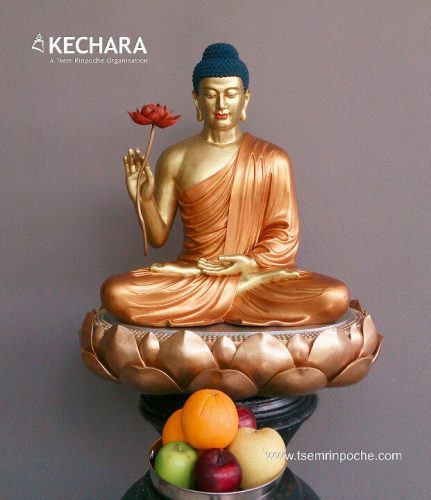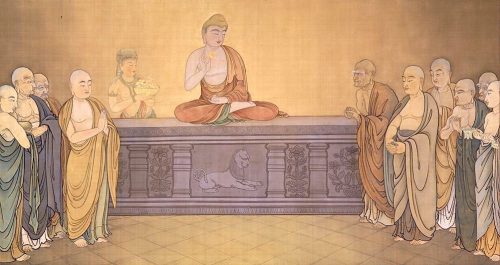The Flower Sermon
9 Feb

Rinpoche recently commissioned a beautiful statue of the Buddha holding a flower in his hand and I was fascinated and I thought a did a little google to find out the basis and was pleasantly surprised to find its connection with the account that sparked the formation of the Chan/Zen lineage.
Within Chan (Zen) Buddhism, the origins of Chan Buddhism are ascribed to what is rendered in English as the “Flower Sermon”. This is where Buddha Shakyamuni transmitted direct transmission of wisdom to the disciple Mahakasyapa. The Flower Sermon was essentially a wordless transmission that encapsulate the ineffable tathata – inexpressible nature of reality.
This comprised the purity of direct transmission of wisdom that Buddha Sakyamuni expressed with a wordless teaching with a white flower to the sangha. This is a flower by which the Buddha had gifted immediately prior to ascending the teaching dais. However, nobody amongst the sangha understood the meaning fo the ‘flower sermon’ except Mahakasyapa, who smiled. According to tradition, the smile signified Mahakasyapa’s direct cognition of wisdom, and Buddha Shakyamuni affirmed this by saying…
“I possess the true Dharma eye, the marvellous mind of Nirvana, the true form of the formless, the subtle Dharma Gate that does not rest on words or letters but is a special transmission outside of the scriptures. This I entrust to Mahakasyapa.”
Thus, a way within Buddhism developed which concentrated on direct experience rather than on rational creeds, doctrinal scholasticism, intellectualism and analysis. Chan/zen is essentially a spiritual discipline, an exploratory methodology that maps consciousness, a meditative tradition that foregrounds direct experience of tathata which may only be forded by the entrance of the ‘gateless’ Dharma Gate.
This is a simple account of the Flower Sermon Sutra, which first appeared in the 11th Century that lead many to believe that it was originally written by fervent Chinese monks in the lineage of Bodhidharma. However, I would like to believe that the actual Indian Sanskrit source no longer survives and that it did originate from India and that the account did take place.






No comments yet